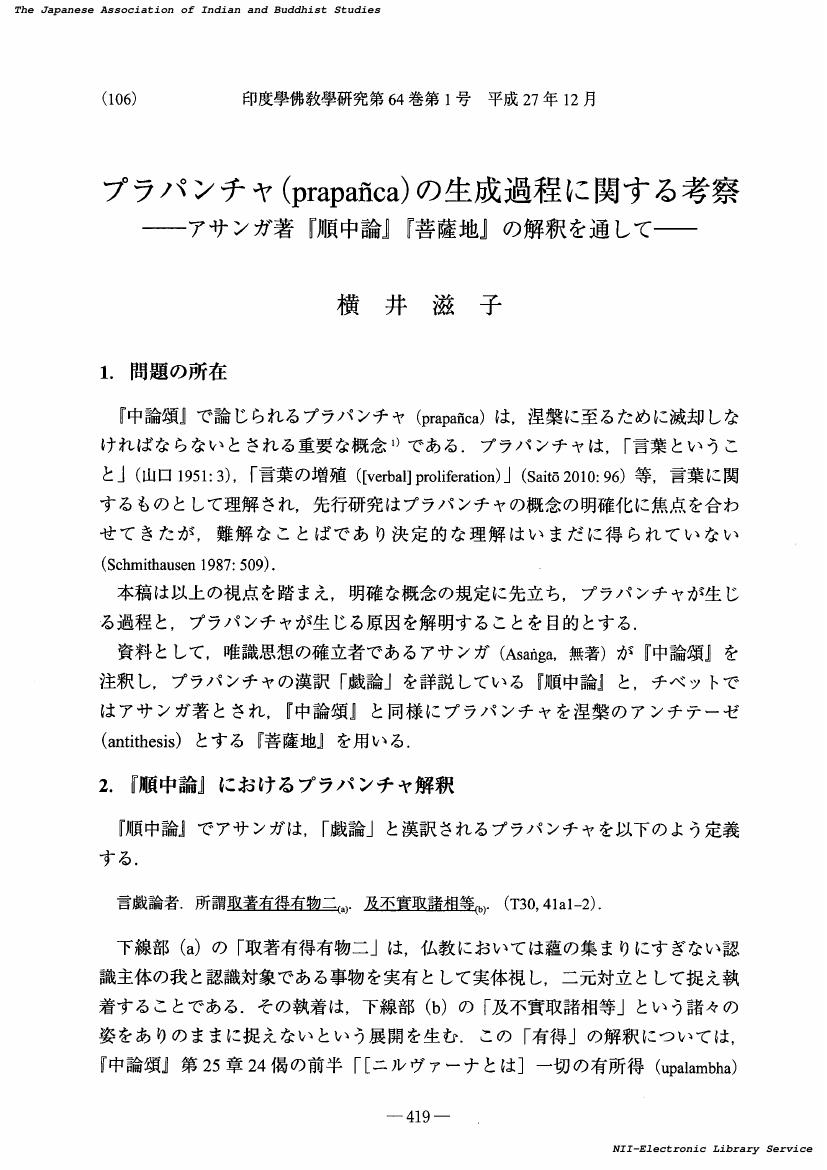1 0 0 0 OA 慈恩大師基の伝記の再検討
- 著者
- 林 香奈
- 出版者
- 日本印度学仏教学会
- 雑誌
- 印度學佛教學研究 (ISSN:00194344)
- 巻号頁・発行日
- vol.59, no.1, pp.242-246, 2010-12-20
1 0 0 0 OA プラパンチャ(prapanca)の生成過程に関する考察
- 著者
- 横井 滋子
- 出版者
- 日本印度学仏教学会
- 雑誌
- 印度學佛教學研究 (ISSN:00194344)
- 巻号頁・発行日
- vol.64, no.1, pp.419-416, 2015-12-20 (Released:2017-09-01)
1 0 0 0 OA 有形象認識論の形象は非真実か?
- 著者
- 片岡 啓
- 出版者
- 日本印度学仏教学会
- 雑誌
- 印度學佛教學研究 (ISSN:00194344)
- 巻号頁・発行日
- vol.67, no.1, pp.374-367, 2018-12-20 (Released:2019-09-07)
- 参考文献数
- 10
When describing the sākārajñānavādipakṣa, i.e., the thesis of those who hold that cognition is endowed with images, Kamalaśīla explicitly states that manifold images (ākāra) are unreal (asatya) and not absolutely true (pāramārthika). His statement can be interpreted as a negation of the theory of citrādvaita common to the Sautrāntikas and the Yogācāras from the higher perspective peculiar to the Yogācāras, particularly in relation to the asallakṣanānupraveśopāya in which grāhya is denied. In other words, this statement should not be taken as an expression of the alīkākāravāda, i.e., the view that images are false. Therefore, we do not have to abandon our common presumption that the sākārajñānavāda is equivalent to what is later called satyākāravāda. Kamalaśīla’s statement is acceptable in the well-established framing of our theoretical understanding. The value of asatya can vary according to whether the contrast is between parikalpita and paratantra, or between paratantra and pariniṣpanna. The issue that Funayama 2007 raised can be solved in this way. Otherwise, we would have to completely give up our common understanding, because what Kamalaśīla calls sākārajñānavāda would correspond to the alīkākāravāda.
1 0 0 0 OA 中世曹洞宗と『無門関』
- 著者
- 龍谷 孝道
- 出版者
- 日本印度学仏教学会
- 雑誌
- 印度學佛教學研究 (ISSN:00194344)
- 巻号頁・発行日
- vol.65, no.2, pp.697-702, 2017-03-20 (Released:2018-01-16)
- 参考文献数
- 6
The Mumonkan shō 無門関抄 kept in the Tanimura Collection in Kyoto University is the lecture report on the Wumen guan 無門関 by the Sōtō sect monk named Ten’ei Shōtei 天英祥貞, active in the Muromachi period. It is the oldest lecture report on the text in existence. By studying the Mumonkan shō, we can investigate the thought of Ten’ei Shōtei and the actual situation of practicing Wumen guan in the medival Sōtō sect. The Wumen guan was extensively studied by monks, and the theories of schools interacted with each other. As a result, I conclude that the importance of Kōan Zen 公案禅 increased in the Sōtō sect.
1 0 0 0 OA バーヴィヴェーカにおける直接知覚と自性分別
- 著者
- 宮本 浩尊
- 出版者
- 日本印度学仏教学会
- 雑誌
- 印度學佛教學研究 (ISSN:00194344)
- 巻号頁・発行日
- vol.56, no.2, pp.896-892, 2008-03-20 (Released:2017-09-01)
1 0 0 0 『解脱道論』における煩惱論について
- 著者
- 遠藤 信一
- 出版者
- 日本印度学仏教学会
- 雑誌
- 印度學佛教學研究 (ISSN:00194344)
- 巻号頁・発行日
- vol.49, no.1, pp.452-449, 2000
1 0 0 0 親鸞聖人本伝和讃について
- 著者
- 福原 亮厳
- 出版者
- 日本印度学仏教学会
- 雑誌
- 印度學佛教學研究 (ISSN:00194344)
- 巻号頁・発行日
- vol.34, no.1, pp.65-74, 1985
1 0 0 0 轉生の理論 -有部思想を中心として-
- 著者
- 福原 亮嚴
- 出版者
- 日本印度学仏教学会
- 雑誌
- 印度學佛教學研究 (ISSN:00194344)
- 巻号頁・発行日
- vol.8, no.2, pp.459-466, 1960
1 0 0 0 佛典に見える物質 (色) の研究 -有部説を中心として-
- 著者
- 福原 亮嚴
- 出版者
- 日本印度学仏教学会
- 雑誌
- 印度學佛教學研究 (ISSN:00194344)
- 巻号頁・発行日
- vol.10, no.1, pp.12-23, 1962
1 0 0 0 親鸞の著作における表現法 -經釋要文を中心として-
- 著者
- 福原 亮嚴
- 出版者
- 日本印度学仏教学会
- 雑誌
- 印度學佛教學研究 (ISSN:00194344)
- 巻号頁・発行日
- vol.16, no.1, pp.310-313, 1967
1 0 0 0 瑜伽論の相応について
- 著者
- 福原 亮厳
- 出版者
- 日本印度学仏教学会
- 雑誌
- 印度學佛教學研究 (ISSN:00194344)
- 巻号頁・発行日
- vol.22, no.1, pp.121-129, 1973
1 0 0 0 西域出土『婆沙論雑抄』について
- 著者
- 福原 亮嚴
- 出版者
- 日本印度学仏教学会
- 雑誌
- 印度學佛教學研究 (ISSN:00194344)
- 巻号頁・発行日
- vol.6, no.1, pp.182-185, 1958
1 0 0 0 浄土論註における仏土観
- 著者
- 福原 亮嚴
- 出版者
- 日本印度学仏教学会
- 雑誌
- 印度學佛教學研究 (ISSN:00194344)
- 巻号頁・発行日
- vol.24, no.2, pp.741-744, 1976
- 著者
- 福原 亮嚴
- 出版者
- 日本印度学仏教学会
- 雑誌
- 印度學佛教學研究 (ISSN:00194344)
- 巻号頁・発行日
- vol.2, no.1, pp.111-112, 1953
1 0 0 0 科学思想と業説との関渉
- 著者
- 福原 亮厳
- 出版者
- 日本印度学仏教学会
- 雑誌
- 印度學佛教學研究 (ISSN:00194344)
- 巻号頁・発行日
- vol.30, no.1, pp.265-268, 1981
1 0 0 0 仏教因果思想と親鸞教義
- 著者
- 福原 亮厳
- 出版者
- 日本印度学仏教学会
- 雑誌
- 印度學佛教學研究 (ISSN:00194344)
- 巻号頁・発行日
- vol.36, no.2, pp.528-533, 1988
1 0 0 0 毘曇と瑜伽との時間論
- 著者
- 福原 亮嚴
- 出版者
- 日本印度学仏教学会
- 雑誌
- 印度學佛教學研究 (ISSN:00194344)
- 巻号頁・発行日
- vol.4, no.1, pp.192-195, 1956
1 0 0 0 転の思想-華厳を中心として-
- 著者
- 福原 亮厳
- 出版者
- 日本印度学仏教学会
- 雑誌
- 印度學佛教學研究 (ISSN:00194344)
- 巻号頁・発行日
- vol.19, no.1, pp.47-52, 1970
- 著者
- 福原 亮厳
- 出版者
- 日本印度学仏教学会
- 雑誌
- 印度学仏教学研究 (ISSN:00194344)
- 巻号頁・発行日
- vol.20, no.2, pp.1-7, 1972-03
1 0 0 0 真宗無我説と仏教・キリスト教
- 著者
- 福原 亮厳
- 出版者
- 日本印度学仏教学会
- 雑誌
- 印度學佛教學研究 (ISSN:00194344)
- 巻号頁・発行日
- vol.26, no.2, pp.538-544, 1978


